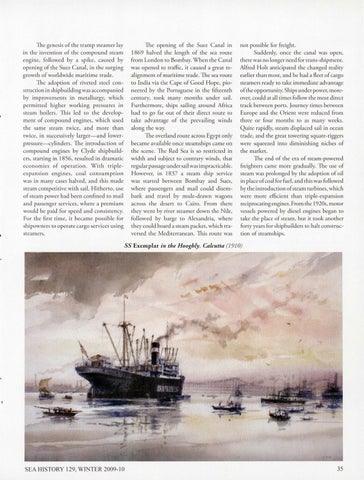The ge nesis of the tramp steamer lay in the invention of the compound steam engin e, followed by a spike, caused by o pening of the Suez Canal, in the surgin g grow th of worldwide maritime trade. The adoption of riveted steel construction in shi pbuildingwas accompanied by improvements in metallurgy, which permitted higher working pressures in steam boilers. This led to the development of compound engines, which used the same steam twice, and more than twice, in successively larger-and lowerpress ure-cylinders. The introduction of compound engines by Clyde shipbuilders, starting in 1856, resulted in dramatic economies of operation. With tripl eexpans ion engin es, coal consumption was in man y cases halved, and this made steam competitive with sail. Hitherto , use of steam power had been confined to m ail and passenger services, where a premium wo uld be paid for speed and consistency. For the first time, it became possible for shipown ers to operate cargo services using steamers.
The opening of the Suez Canal in 1869 halved the length of the sea route from London to Bombay. When the Canal was opened to traffic, it caused a great realignment of maritime trade. The sea route to India via the Cape of Good Hope, pioneered by the Portuguese in the fifteenth century, rook many months under sail. Furthermore, ships sailing aro und Africa had to go far out of their direct route to take advantage of the prevailing winds along the way. The overland route across Egypt only became available once steamships came on the scene. The Red Sea is so restri cted in width and subject to contrary winds, that regular passage under sail was impracticable. However, in 1837 a steam ship service was started between Bo mbay and Suez, where passengers and mai l could disembark and travel by mule-draw n wago ns across the desert to Cairo. From there they went by river steamer down the N ile, followed by barge to Alexandria, where they could board a steam packer, which traversed the Mediterranean. This route was
not possible for freight. Suddenly, once the canal was open , there was no longe r need for trans-shipment. Alfred Holt anti cipated the changed reality earlier than most, and he had a fleet of cargo steam ers ready to rake immediate advantage of the opportunity. Ships under power, moreover, could at al l times follow the most direct track between ports. Journey rimes between Europe and the Orient were reduced from three o r four months to as many weeks. Quire rapidly, steam displ aced sail in ocean trade, and the great towering square-rigge rs were squeezed into diminishing niches of the marker. Th e end of the era of steam-powered freighters came mo re gradually. Th e use of steam was prolo nged by the adoptio n of o il in place of coal for fuel , and this was followed by the introductio n ofsteam turbines, which were more efficient than triple-expansio n reciprocating engines. From the 1920s, motor vessels powered by diesel engines began to take the pl ace of steam , but it rook another forty years for shipbuilders to halt construction of steamships.
SS Exemplar in the Hooghly, Calcutta (1910)
SEA HISTORY 129, WINTER 2009-10
35
